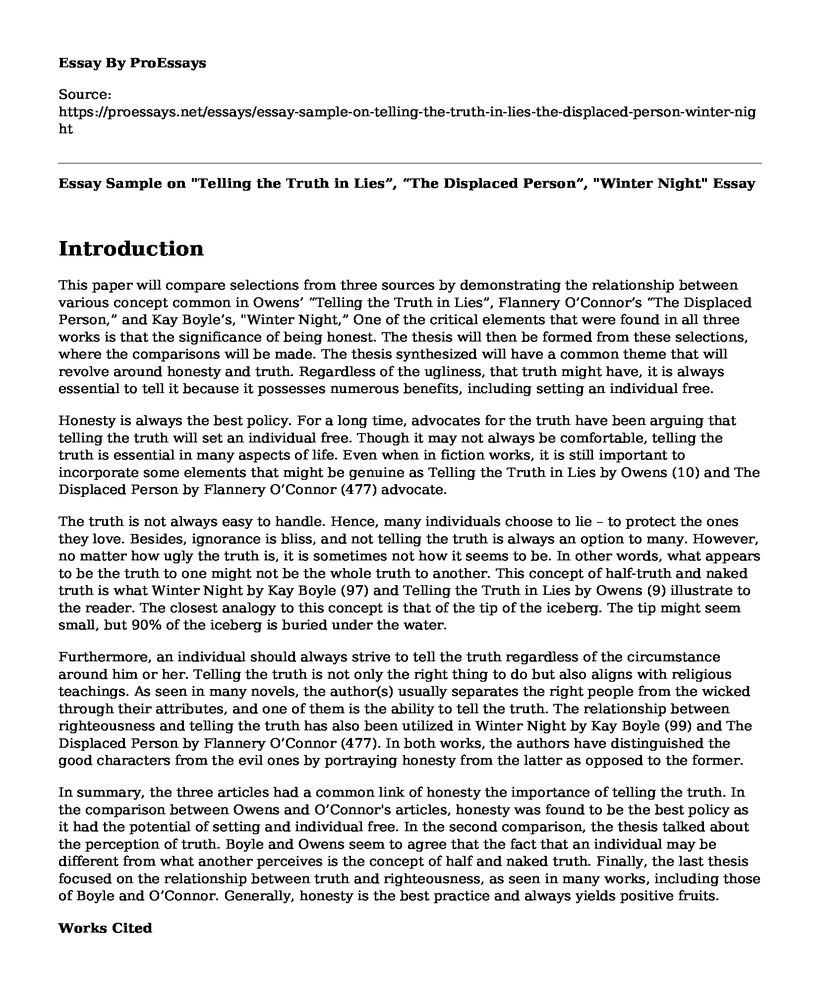Introduction
This paper will compare selections from three sources by demonstrating the relationship between various concept common in Owens’ “Telling the Truth in Lies”, Flannery O’Connor’s “The Displaced Person,” and Kay Boyle’s, "Winter Night,” One of the critical elements that were found in all three works is that the significance of being honest. The thesis will then be formed from these selections, where the comparisons will be made. The thesis synthesized will have a common theme that will revolve around honesty and truth. Regardless of the ugliness, that truth might have, it is always essential to tell it because it possesses numerous benefits, including setting an individual free.
Honesty is always the best policy. For a long time, advocates for the truth have been arguing that telling the truth will set an individual free. Though it may not always be comfortable, telling the truth is essential in many aspects of life. Even when in fiction works, it is still important to incorporate some elements that might be genuine as Telling the Truth in Lies by Owens (10) and The Displaced Person by Flannery O’Connor (477) advocate.
The truth is not always easy to handle. Hence, many individuals choose to lie – to protect the ones they love. Besides, ignorance is bliss, and not telling the truth is always an option to many. However, no matter how ugly the truth is, it is sometimes not how it seems to be. In other words, what appears to be the truth to one might not be the whole truth to another. This concept of half-truth and naked truth is what Winter Night by Kay Boyle (97) and Telling the Truth in Lies by Owens (9) illustrate to the reader. The closest analogy to this concept is that of the tip of the iceberg. The tip might seem small, but 90% of the iceberg is buried under the water.
Furthermore, an individual should always strive to tell the truth regardless of the circumstance around him or her. Telling the truth is not only the right thing to do but also aligns with religious teachings. As seen in many novels, the author(s) usually separates the right people from the wicked through their attributes, and one of them is the ability to tell the truth. The relationship between righteousness and telling the truth has also been utilized in Winter Night by Kay Boyle (99) and The Displaced Person by Flannery O’Connor (477). In both works, the authors have distinguished the good characters from the evil ones by portraying honesty from the latter as opposed to the former.
In summary, the three articles had a common link of honesty the importance of telling the truth. In the comparison between Owens and O’Connor's articles, honesty was found to be the best policy as it had the potential of setting and individual free. In the second comparison, the thesis talked about the perception of truth. Boyle and Owens seem to agree that the fact that an individual may be different from what another perceives is the concept of half and naked truth. Finally, the last thesis focused on the relationship between truth and righteousness, as seen in many works, including those of Boyle and O’Connor. Generally, honesty is the best practice and always yields positive fruits.
Works Cited
Flannery O’Connor, “The Displaced Person,” Encounters, 477
Kay Boyle, "Winter Night," Encounters, 97-102
Owens, Virginia Stem. “Telling the Truth in Lies.” Encounters: Readings for Advanced Composition, edited by Mark Hall and William Epperson, 2nd ed., Kendall Hunt, 2019, pp. 9-12
Cite this page
Essay Sample on "Telling the Truth in Lies", "The Displaced Person", "Winter Night". (2023, Aug 17). Retrieved from https://proessays.net/essays/essay-sample-on-telling-the-truth-in-lies-the-displaced-person-winter-night
If you are the original author of this essay and no longer wish to have it published on the ProEssays website, please click below to request its removal:
- Analysis of Alexander Pope's "An Essay on Man"
- A Review of the Book Confucius Lives Next Door
- Literary Analysis Essay on Joseph Conrad's Heart of Darkness
- Poetry Analysis Essay on "College of Echos" by Isabella Gardner
- Eileen Chang: Iconic Writer and Hall of Fame Icon - Essay Sample
- Essay Example on Cupcake's Misery: A Story of Divorce, Death and Foster Care
- Essay on the Dark Side of Human Interventions: How Too Much Progress is Crippling Society







